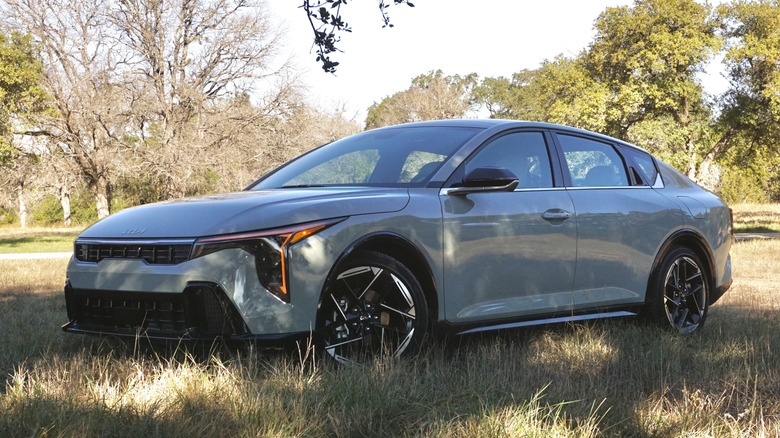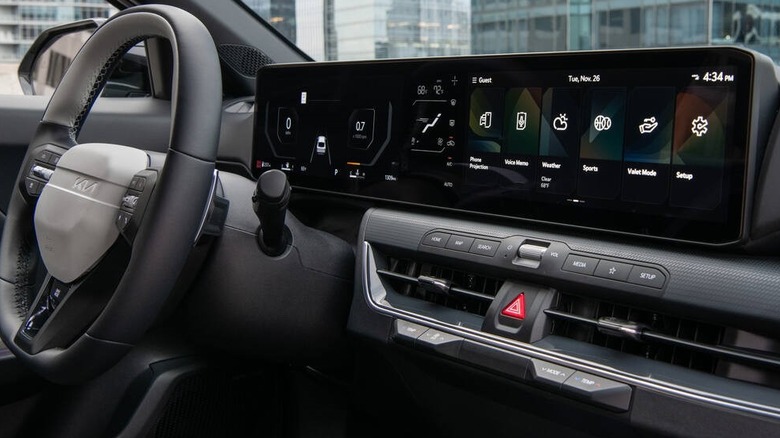2025 Kia K4 First Drive: Bigger And More Upscale But Facing Tough Competition
Kia's new compact sedan is a real looker. The 2025 Kia K4 is the birth of a nameplate that slots in below their midsize sedan, the K5, and it's all-new on the surface. The styling is sleek, it aligns well with Kia's other sedans, and it promises affordable and spacious motoring in the compact segment. Beneath the skin, however, it shares a lot of its parts with the outgoing Kia Forte.
In fact, the K4 replaces the Forte as Kia's compact sedan and it does so with larger dimensions and a more upscale vibe, positioning itself to do battle with class leaders like the Toyota Corolla, Mazda 3, and Honda Civic. But the K4 is still powered by the same choice of two different four-cylinder engines, one with less power than before and both with more weight to carry around. So beyond style, does it have what it takes to duke it out with the best compact sedans on the market? Kia invited SlashGear out to Texas to drive the new K4 and find out.
Bigger but heavier, too
Driving the 2025 Kia K4 on city streets, big Lone-Star-state highways, and curvy back roads outside of Austin, it felt small and manageable. Parking was easy and maneuvering through tight spaces, it felt right-sized for city life. It also felt big enough for long, comfortable road trips with plenty of front and rear legroom, and that's no accident. Kia has made the K4 significantly larger than the Forte, with space and comfort in mind.
From nose to tail, the K4 is 185.4 inches long. That's almost three inches longer than the outgoing Forte (182.7). It's also 0.6 inches longer than one of its largest compact rivals, the Honda Civic (184.8), and over 3 inches longer than both the Toyota Corolla sedan (182.3). At 72.8 inches wide, the K4 is 1.9 inches wider than the Forte too.
As you might expect, the extra size does translate to some extra weigh. The lightest Forte checked in at 2,769 lbs, while the lightest K4 is 2,932 lbs. It's mostly the same story across most of the Forte and K4 lineups, with similarly-equipped models being separated by about 200-300 pounds. That's not a huge difference, but it does come into play when you consider the K4's available powertrains.
Kia's base K4 engine underwhelms
My time in Texas driving the new K4 was split between two different trim levels: a K4 GT-Line with the Premium Package and the base 2.0-liter engine ($28,345 as tested), and a GT-Line Turbo with the Tech Package and the turbocharged 1.6-liter engine ($31,455 as tested). Both versions of the K4 had their own unique characteristics, though there were clear reasons to pay for the turbo upgrade.
With just 147 horsepower and 132 lb-ft of torque, the K4's standard four-cylinder is one of the more underwhelming choices in the class. Burying the throttle motivates the K4 in an uninspiring way, with long, noisy acceleration pulls at speed. Passing maneuvers will take a lot of planning and, despite the paddle shifters mounted behind the steering wheel, driving this particular trim didn't feel sporty at all.
This isn't a rare set of driving characteristics for base-engine-equipped compact sedans in the segment, only it's an area where the K4 could've set itself apart from rivals, but doesn't. Thankfully, the optional turbocharged engine is a bit more lively.
Getting behind the wheel of the GT-Line Turbo
The K4's turbocharged 1.6-liter engine is clearly the choice for drivers who want more engagement to go with the styling. It produces 190 hp and 195 lb-ft of torque, much more respectable numbers and in line with some of the sporty rivals in the class. Unfortunately, that's 11 fewer horsepower than the Forte got with the same engine.
To get the K4 to meet modern fuel economy standards, the engine tuning was adjusted slightly and the result was less peak power. According to Kia representatives I spoke to, there are no significant hardware changes, just tuning, but with the combination of less power and extra weight, the K4 does lose some of its appeal.
Instead of being paired with the IVT, the turbocharged engine is hooked up to an 8-speed automatic transmission that's a bit more engaging (unfortunately, there's no longer a manual transmission available). Like with the GT-Line K4 I drove, the GT-Line Turbo came with paddle shifters mounted behind the steering wheel, but they didn't offer much of a benefit over letting the K4 do its own shifting: downshifts and upshifts both show a significant amount of lag, from when you click the paddle to when the shift happens. Without doubt, the turbocharged 1.6-liter engine is more entertaining and it's the engine I'd choose, but rivals like the manual-transmission Civic Si are more appealing for maximum driving fun.
A classy and quiet interior with some high-end features
Elegant on the outside, the K4 backs up its exterior looks with a pretty refined interior. The ride quality in both cars I drove around Austin was smooth, with only a few bumps and road imperfections making their way into the cabin. Interior materials and build quality felt upscale, too. Having a quiet conversation with a passenger at highway speed was easy – no need to shout in here.
Up front, well-padded and heated seats are standard on the GT-Line and GT-Line Turbo models, but unavailable on lower trims. There's plenty of bolstering for a bit of cornering fun and the heating elements worked well on the cold Texas morning behind the wheel of the K4. Ventilated seats are optional on just the GT-Line trims, a nice find in the compact sedan segment, but only available at the premium level.
Physical climate controls are easy to spot and adjust on the center of the dashboard, but — like with the same layout on the EV9 — seeing the climate control display sandwiched between the two dashboard display screens is difficult. From the driver's position, the small screen is obstructed by the steering wheel, and you need to lean to the right to see it fully.
Tech is easy to use with two big screens
On lower trims, the K4 gets a 4-inch driver display, but on upper trims there are two large screens: one for the driver and one for the center touchscreen. The pair of 12.3-inch displays give these upper-trim K4s an upscale vibe from the moment you sit down. Connecting to Apple CarPlay or Android Auto via wireless or wired connection was easy — no drop connections during this test. The graphics are excellent on both screens, and the displays are high-contrast enough to be visible even when there's direct sunlight on them.
The 8-speaker Harman Kardon stereo, however, was a bit of a letdown. Optional on the GT-Line and standard on the GT-Line Turbo, the stereo didn't provide particularly dynamic audio at higher volumes. At low and medium volumes it was relatively clear, but bass dropped out quite a bit when the knob was cranked all the way up. Audiophiles will want better performance.
The size increase makes for a spacious compact sedan
The K4's bigger exterior dimensions over the Forte add some significant interior space, both noticeable from behind the wheel and while you're in the back seat. Legroom in both the front and rear is excellent, with enough space for tall drivers and tall passengers. Finding a good driving position is no sweat, with a tilt-and-telescoping steering wheel that provides plenty of range and a driver's seat with plenty of adjustability.
Getting in and out is easy too, thanks to wide door openings. The rear door handles could be confusing for first timers though. If you've ever watched someone try to figure out the door handles on a Tesla Model 3 when it arrives as their Uber, you'll understand what it looked like when I tried loading my laptop bag into the back seat of the K4. On top of being in a strange location, the rear door handles are color-matched to the black trim, so they're hard to see.
With 14.6 cubic feet of cargo space in the trunk, the K4 doesn't have the most space in the class, but it's close: that's just 0.2 cubic feet less than a Civic sedan (14.8) which is one of the most spacious compact sedans. Big suitcases will fit in the K4's trunk just fine, and several small carry-on sized bags can be accommodated without any issues.
2025 Kia K4 Verdict
Pricing is a big part of the K4's appeal. Kia is proud of the fact that the K4 is one of very few vehicles that starts out with an MSRP under $22,000 (leaving out the $1,155 destination fee, of course). The base model starts at $23,145 including destination, which is cheaper than most compact sedans and hatchbacks, though there's some stiff competition.
A base 2025 Honda Civic, for example, checks in at $25,345 (including $1,095 destination) which isn't a very large difference when you consider just how good the Honda is. If your budget is tighter, there's the 2025 Nissan Sentra at $22,730 (including $1,140 destination), although its lower trims simply aren't as desirable. Then, of course, there's the K4's cousin, the Elantra, which has a starting price of $23,025 (including $1,150 destination) and much of the same equipment as the K4. As mentioned our GT-Line Turbo test model had an MSRP of $31,455 (including destination) which puts it in the same category as the excellent Honda Civic Sport Hybrid and the Mazda3 2.5 Carbon Turbo.
The new 2025 Kia K4 is stylish and refined, and certainly an improvement over the forgettably-designed Forte when it comes to comfort and space. Even with all of Kia's upgrades, though, you'll want to take a long, hard look at the K4's rivals: it's now in competition with some of the best compact sedans you can buy.











